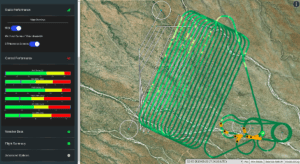
Colorado-based Black Swift Technologies is helping the U.S. Air Force improve drone maintenance planning, thanks to a recent grant.
The company will develop a machine-learning software solution for predicting and improving maintenance schedules in an effort to reduce drone systems failures.
“System failures can be costly—in time, money and equipment,” Black Swift CEO Jack Elston said.
“Our solution uses unsupervised learning for anomaly detection, which leverages algorithms that can build a model of how an aircraft should behave across a wide range of missions and flight conditions, then watch for instances that violate these models.”
Since many drone systems lack onboard monitoring or systematic maintenance, some users are forced to rely on guides printed in owner’s manuals to determine maintenance schedules—a limited solution at best.
While detailed maintenance logs and schedules are standard for manned aircraft, small drones may suffer from a lack of subsystem status information—critical components such as servos are often open-loop and unmonitored.
“Leveraging artificial intelligence and machine learning will allow us to build a smarter predictive maintenance schedule for UAS vehicles,” Elston added. “In doing so we can ensure these UAS are operational in the sky, safe for people on the ground, and remain mission ready at all times.”
How it works
Black Swift’s platform will use unsupervised machine learning algorithms to provide early warning and diagnostics of potential critical drone system failures. The system gathers critical information from avionics data the Air Force already collects. If the data proves insufficient, a set of monitoring nodes can be used to install “aboard-candidate” platforms to supplement the data sets and implement algorithms for real-time analysis and feedback.
Black Swift news
Earlier this year, Black Swift won a NOAA contract to develop GPS-denied navigation, enabling Beyond Visual Line of Sight (BVLOS) operations for drones in GNSS-denied environments.
In 2018, the company announced the release of the Black Swift S2 UAS—described as a “tightly integrated small Unmanned Aerial System (sUAS) specifically designed to meet the needs of atmospheric and earth-observing scientific field campaigns.”
The fruits of a partnership with NASA and University of Colorado (CU) Boulder Integrated Remote and In Situ Sensing (IRISS), the S2 platform encompasses airframe, avionics, and sensors specifically designed to measure atmospheric parameters such as temperature, pressure, humidity and winds; the system can hoist up to 5 pounds of additional payload.
Jason is a longstanding contributor to DroneLife with an avid interest in all things tech. He focuses on anti-drone technologies and the public safety sector; police, fire, and search and rescue.
Beginning his career as a journalist in 1996, Jason has since written and edited thousands of engaging news articles, blog posts, press releases and online content.
Email Jason
TWITTER:@JasonPReagan
Subscribe to DroneLife here.